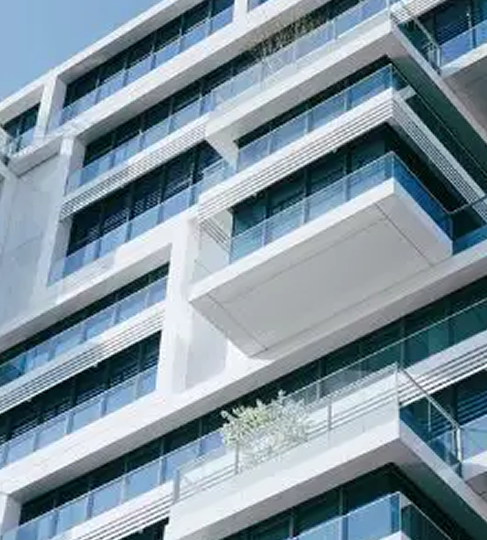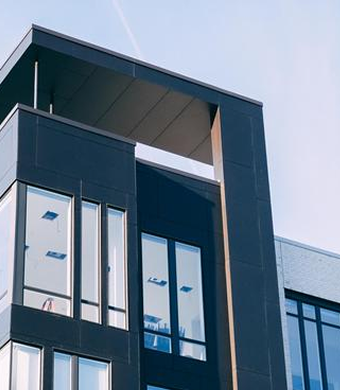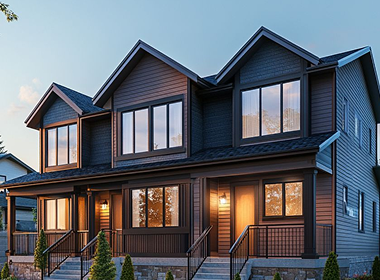

An innovative mortgage-loan insurance product that rewards your commitment to affordability, accessibility, and energy efficiency. Unlock reduced premiums, longer amortizations, and enhanced investment returns
The CMHC Mortgage Loan Insurance (MLI) Select program offers graduated premium incentives and amortization flexibilities for multi-unit rental projects that meet elevated social and environmental standards. Whether you’re developing new construction or retrofitting existing buildings, MLI Select helps you:
Finance up to 85–95% loan-to- cost (vs. 80% standard) on qualifying projects.
Up to 100 points’ worth of energy, accessibility, and affordability commitments can yield rate reductions, improving your project’s bottom line.
Borrowers may access up to 50-year amortizations for deep-green builds.
Borrowers may access up to 50-year amortizations for deep-green builds.Canada Mortgage and Housing Corporation



MLI Select is a CMHC program that offers significant benefits for real estate investors. The program provides premium reductions and favorable financing terms for properties that meet specific energy efficiency, accessibility, and affordability criteria.


Properties with higher energy efficiency ratings qualify for greater premium reductions. Features include.


Properties with accessibility features score higher in the MLI Select program. Features include.


Properties that offer affordable housing solutions receive higher scores. Features include.
MLI Select uses a transparent, three-pillar point system. Your total score determines your premium rate, LTV, amortization, and recourse options.
Reserve 40–80% of units at 30% of median renter income for at least ten years.
An extra 30 points if commitment exceeds 20 years.
Reserve 10–25% of units at 30% of median renter income for at least ten years.
An extra 30 points if commitment exceeds 20 years.
Achieve 15–40% reduction from current performance benchmarks.
Exceed code by 20–40% (measured against 2017 NECB / 2015 NBC).
Ensure 15–100% of units are visitable or universal-design compliant.
Ensure 15–100% of units are visitable or universal-design compliant.
Units must comply with CSA B651:23 visitability or universal-design standards; Rick Hansen Foundation certification accepted.
Energy efficiency is measured against 2017 NECB / 2015 NBC for new construction.
Points from all three pillars can be combined to achieve your target score. A minimum of 50 points is required to qualify for MLI Select benefits.
Your total MLI Select points unlock tailored financing features that can significantly improve your project's financial performance.
Higher scores unlock progressively better financing terms. Compare the key benefits below:
| Benefit | Value | Description |
|---|---|---|
| Maximum LTV | 85% | Loan-to-value ratio determines how much you can borrow against the property value |
| Amortization | 40 years | Extended amortization period reduces monthly payments and improves cash flow |
| Debt-Service Coverage | 1.10 | Lower debt-service coverage ratio requirement improves borrowing capacity |
| Recourse | Full | Standard recourse requirements apply |
| Replacement Reserve | Discretionary | Flexible approach to replacement reserve requirements |
| Benefit | Value | Description |
|---|---|---|
| Maximum LTV | 95% | Significantly higher loan-to-value ratio reduces equity requirements |
| Amortization | 45 years | Further extended amortization period for even lower monthly payments |
| Debt-Service Coverage | 1.10 | Lower debt-service coverage ratio requirement improves borrowing capacity |
| Recourse | Full | Standard recourse requirements apply |
| Replacement Reserve | Discretionary | Flexible approach to replacement reserve requirements |
| Benefit | Value | Description |
|---|---|---|
| Maximum LTV | 95% | Significantly higher loan-to-value ratio reduces equity requirements |
| Amortization | 50 years | Maximum amortization period for lowest possible monthly payments |
| Debt-Service Coverage | 1.10 | Lower debt-service coverage ratio requirement improves borrowing capacity |
| Recourse | Limited | Reduced recourse requirements lower risk for borrowers |
| Replacement Reserve | Discretionary | Flexible approach to replacement reserve requirements |
Key Benefit
Higher-scoring projects see more favorable debt-structure, longer terms, and limited-recourse options—boosting cash flow and lowering risk. Each 10-point increase in your score can translate to tNEWAB housends in annual savings.
CMHC MLI Select is available for both new construction and existing rental projects, including standard market-rental buildings, supportive or social housing, single-room occupancies (SROs), and retirement homes. Student residences qualify only under the energy-efficiency and accessibility pillars. Key scale thresholds are:
MLI Select measures commitment across three equally weighted pillars. Achieving baseline performance in any one pillar unlocks initial incentives; excelling in two or all three drives deeper benefits.
Reserve a percentage of units at 30% of the local median renter income for at least ten years.
Demonstrate improvement over baseline energy codes (2017 NECB / 2015 NBC for new builds) through third-party modelling or certifications (e.g., ENERGY STAR for multi-unit projects).
Ensure 100% of units are "visitable" (in accordance with CSA B651:23) and deliver a minimum share of fully accessible or universal-design units.
Your total MLI Select score (0–100 points) directly determines financing features:
Even a single-pillar commitment can unlock significant rate discounts; combining two or three pillars maximizes your capital efficiency and cash-flow benefits.
By adhering strictly to these CMHC-defined requirements—project scale, pillar performance, legal compliance, and point thresholds—you’ll position your rental development for the most favorable mortgage-loan insurance incentives available in Canada.
Navigate the CMHC MLI Select application process with our expert guidance.
Your journey begins with a one-hour strategic discussion involving you, your CMHC-approved lender, and our MLI Select specialists. In this call we will:
This foundational step ensures alignment across all stakeholders and sets expectations for a smooth application.
With clarity on your target score and financing structure, the next 2–3 weeks are dedicated to compiling the technical and financial evidence CMHC requires:
Pro tip: Organize all documents in a shared portal with clear filenames (e.g., “Energy_Audit_ProjectName.pdf”) to streamline both lender and CMHC review.
Once your dossier is complete, your lender submits a pre-screen package to CMHC Underwriting. This early review, typically delivered within 10 business days, provides:
This low-commitment step helps you refine your application before full submission and reduces the risk of downstream surprises.
Armed with pre-screen feedback, your lender formally files the complete application package with CMHC Underwriting. During this 6–8-week period, our team:
Clear, proactive communication at this stage prevents delays and ensures CMHC’s questions are answered the first time around.
As CMHC Underwriting assesses your submission, you can expect:
Our specialists will coordinate these exchanges, keeping your project on track by ensuring rapid turnaround on any supplemental data requests.
Upon successful underwriting, CMHC issues your official MLI Select Certificate of Insurance, at which point you:
With insurance in place, you move confidently into project execution—knowing your financing structure is optimized for cash flow, risk mitigation, and long-term portfolio growth.
Typical Turnaround: From formal submission to policy in hand, most CMHC MLI Select applications complete within 6–8 weeks, provided documentation is thorough and supplemental requests are handled swiftly.
Case Study Details
Each study includes before/after financials, lender feedback, and tenant impact.
Get answers to the most common questions about the CMHC MLI Select program.
Get personalized assistance with your CMHC MLI Select application.